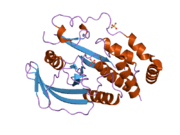PTPN4
Tyrosine-protein phosphatase non-receptor type 4 is an enzyme that in humans is encoded by the PTPN4 gene.[1][2]
Function
The protein encoded by this gene is a member of the protein tyrosine phosphatase (PTP) family. PTPs are known to be signaling molecules that regulate a variety of cellular processes including cell growth, differentiation, mitotic cycle, and oncogenic transformation. This protein contains a C-terminal PTP domain and an N-terminal domain homologous to the band 4.1 superfamily of cytoskeletal-associated proteins. This PTP has been shown to interact with glutamate receptor delta 2 and epsilon subunits, and is thought to play a role in signalling downstream of the glutamate receptors through tyrosine dephosphorylation.[2]
Interactions
PTPN4 has been shown to interact with GRID2.[3]
References
- ↑ Gu MX, York JD, Warshawsky I, Majerus PW (August 1991). "Identification, cloning, and expression of a cytosolic megakaryocyte protein-tyrosine-phosphatase with sequence homology to cytoskeletal protein 4.1". Proc Natl Acad Sci U S A 88 (13): 5867–71. doi:10.1073/pnas.88.13.5867. PMC 51979. PMID 1648233.
- ↑ 2.0 2.1 "Entrez Gene: PTPN4 protein tyrosine phosphatase, non-receptor type 4 (megakaryocyte)".
- ↑ Hironaka K, Umemori H, Tezuka T, Mishina M, Yamamoto T (May 2000). "The protein-tyrosine phosphatase PTPMEG interacts with glutamate receptor delta 2 and epsilon subunits". J. Biol. Chem. 275 (21): 16167–73. doi:10.1074/jbc.M909302199. PMID 10748123.
Further reading
- Gu M, Majerus PW (1996). "The properties of the protein tyrosine phosphatase PTPMEG". J. Biol. Chem. 271 (44): 27751–9. doi:10.1074/jbc.271.44.27751. PMID 8910369.
- Gu M, Meng K, Majerus PW (1996). "The effect of overexpression of the protein tyrosine phosphatase PTPMEG on cell growth and on colony formation in soft agar in COS-7 cells". Proc. Natl. Acad. Sci. U.S.A. 93 (23): 12980–5. doi:10.1073/pnas.93.23.12980. PMC 24032. PMID 8917530.
- Hironaka K, Umemori H, Tezuka T, Mishina M, Yamamoto T (2000). "The protein-tyrosine phosphatase PTPMEG interacts with glutamate receptor delta 2 and epsilon subunits". J. Biol. Chem. 275 (21): 16167–73. doi:10.1074/jbc.M909302199. PMID 10748123.
- Gjörloff-Wingren A, Saxena M, Han S, Wang X, Alonso A, Renedo M et al. (2000). "Subcellular localization of intracellular protein tyrosine phosphatases in T cells". Eur. J. Immunol. 30 (8): 2412–21. doi:10.1002/1521-4141(2000)30:8<2412::AID-IMMU2412>3.0.CO;2-J. PMID 10940933.
- Park KW, Lee EJ, Lee S, Lee JE, Choi E, Kim BJ et al. (2001). "Molecular cloning and characterization of a protein tyrosine phosphatase enriched in testis, a putative murine homologue of human PTPMEG". Gene 257 (1): 45–55. doi:10.1016/S0378-1119(00)00351-6. PMID 11054567.
- Stelzl U, Worm U, Lalowski M, Haenig C, Brembeck FH, Goehler H et al. (2005). "A human protein-protein interaction network: a resource for annotating the proteome". Cell 122 (6): 957–68. doi:10.1016/j.cell.2005.08.029. PMID 16169070.
PDB gallery |
|---|
| | 2cs5: Solution structure of PDZ domain of Protein tyrosine phosphatase, non-receptor type 4 |
| 2i75: Crystal Structure of Human Protein Tyrosine Phosphatase N4 (PTPN4) |
|
|
|


